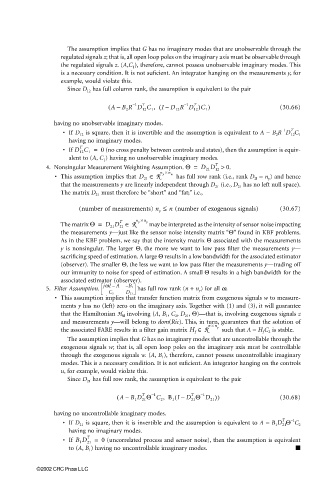Page 903 - The Mechatronics Handbook
P. 903
0066_Frame_C30 Page 14 Thursday, January 10, 2002 4:43 PM
The assumption implies that G has no imaginary modes that are unobservable through the
regulated signals z; that is, all open loop poles on the imaginary axis must be observable through
the regulated signals z. (A,C 1 ), therefore, cannot possess unobservable imaginary modes. This
is a necessary condition. It is not suficient. An integrator hanging on the measurements y, for
example, would violate this.
Since D 12 has full column rank, the assumption is equivalent to the pair
1
(
T
1
–
T
( AB 2 R D 12 C 1 , ID 12 R D 12 )C 1 ) (30.66)
–
–
–
having no unobservable imaginary modes.
−1 T
• If D 12 is square, then it is invertible and the assumption is equivalent to A − B 2 R D 12 C 1
having no imaginary modes.
T
• If D 12 C 1 = 0 (no cross penalty between controls and states), then the assumption is equiv-
alent to (A, C 1 ) having no unobservable imaginary modes.
T
4. Nonsingular Measurement Weighting Assumption. Θ = D 21 D > . 0
12
• This assumption implies that D 21 ∈ R n × n w has full row rank (i.e., rank D 2l = n y ) and hence
y
that the measurements y are linearly independent through D 21 (i.e., D 21 has no left null space).
The matrix D 21 must therefore be “short” and “fat;” i.e.,
(number of measurements) n ≤ n (number of exogenous signals) (30.67)
y
T
y
The matrix Θ = D 21 D 21 ∈ R n × n y may be interpreted as the intensity of sensor noise impacting
the measurements y—just like the sensor noise intensity matrix “Θ” found in KBF problems.
As in the KBF problem, we say that the intensity matrix Θ associated with the measurements
y is nonsingular. The larger Θ, the more we want to low pass filter the measurements y—
sacrificing speed of estimation. A large Θ results in a low bandwidth for the associated estimator
(observer). The smaller Θ, the less we want to low pass filter the measurements y—trading off
our immunity to noise for speed of estimation. A small Θ results in a high bandwidth for the
associated estimator (observer).
jwI – A –
5. Filter Assumption. B 1 has full row rank (n + n y ) for all w.
C 2 D 21
• This assumption implies that transfer function matrix from exogenous signals w to measure-
ments y has no (left) zero on the imaginary axis. Together with (1) and (3), it will guarantee
that the Hamiltonian H fil involving (A, B 1 , C 2 , D 21 , Θ)—that is, involving exogenous signals z
and measurements y—will belong to dom(Ric). This, in turn, guarantees that the solution of
n ×
the associated FARE results in a filter gain matrix H f ∈ R n y such that A − H f C 2 is stable.
The assumption implies that G has no imaginary modes that are uncontrollable through the
exogenous signals w; that is, all open loop poles on the imaginary axis must be controllable
through the exogenous signals w. (A, B 1 ), therefore, cannot possess uncontrollable imaginary
modes. This is a necessary condition. It is not suficient. An integrator hanging on the controls
u, for example, would violate this.
Since D 21 has full row rank, the assumption is equivalent to the pair
T
(
–
1
–
T
1
( AB 1 D 21 Θ C 2 ,B 1 ID 21 Θ D 21 )) (30.68)
–
–
having no uncontrollable imaginary modes.
T −1
• If D 21 is square, then it is invertible and the assumption is equivalent to A − B 1 D 21 Θ C 2
having no imaginary modes.
T
• If B 1 D 21 = 0 (uncorrelated process and sensor noise), then the assumption is equivalent
to (A, B 1 ) having no uncontrollable imaginary modes.
©2002 CRC Press LLC

